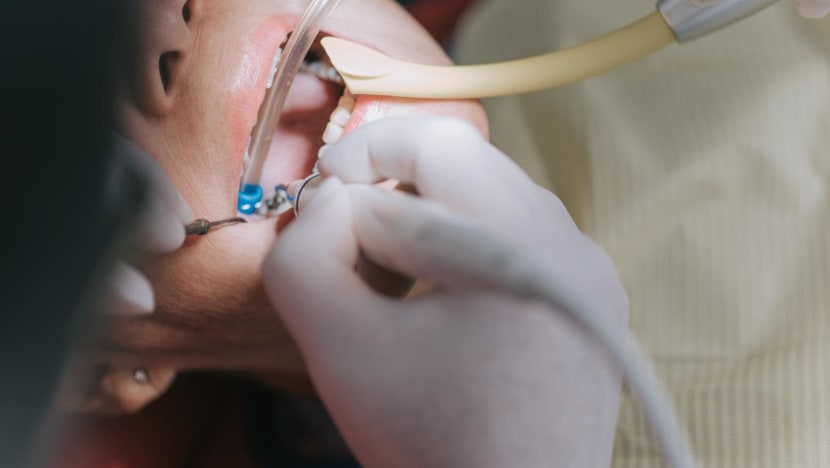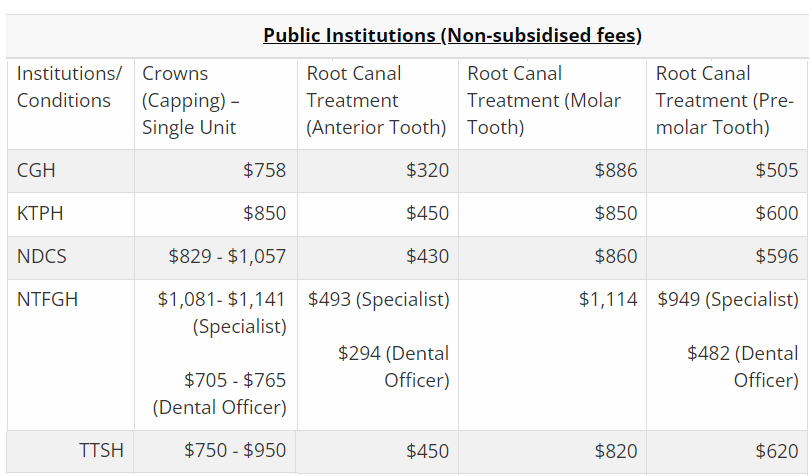Why are root canal treatments so expensive, and what options do you have if you need one?
The cost of root canal treatments depends on several factors such as tooth type and complexity of the procedure, says an oral health expert.

A dentist examines a patient's teeth. (File photo: iStock)
SINGAPORE: When Mr Lee found out how much a root canal treatment would cost him, his first thought was to extract the tooth.
“(When) they told me about the price, I was hesitant because it’s quite pricey,” said the 26-year-old, who only wanted to be known by his surname.
The wedding videographer first visited a neighbourhood dental clinic in Bedok in February after experiencing a “very bad” toothache.
Although the toothache began last year, it wasn’t until he was having a meal one day that the pain became so unbearable that he could not chew his food at all.
“It was so painful (until) I had quite a bad headache," said Mr Lee. "That’s when I realised (I had) to go and check.”
The dentist he visited suggested two options: He could either extract the tooth or get a root canal treatment. The procedure involves disinfecting and cleaning the root canal space and filling it up to prevent reinfection.
“A lot of people decide to pluck (their teeth) because they know the root canal is going to be really expensive,” Mr Lee told CNA.
In his case, the dentist told him the tooth “could still be saved”. He advised Mr Lee to go ahead with the root canal as he was still young and the affected tooth was located at the back of the mouth and is important for chewing.
Mr Lee took the advice and got his X-rays done at a neighbourhood clinic. The next day, he had his first root canal treatment at Royal Healthcare Medical Centre, a specialist clinic in Novena.
After another two to three sessions with the specialist, he went back to the neighbourhood clinic to get a dental crown – a cap placed over a tooth to restore its look and function.
The whole process, which took less than six months, cost Mr Lee more than S$2,600 (US$1,960) for both the root canal and the dental crown.
He is not the only one who has spent thousands on a root canal treatment here in Singapore.
Assistant marketing manager May Ho similarly paid S$2,400 for both procedures when she sought treatment three years ago.
Ms Ho, who is in her early 40s, told CNA that she was first advised to get a dental crown when she was in primary school.
But she did not, as there was no pain and she saw “no reason” to visit the dentist. It was only after many years when she started to feel discomfort that she decided to visit a dentist.
Like Mr Lee, she was recommended a root canal, which she got done at The Oral Care Centre in Novena.
While Ms Ho, who works at the National University of Singapore, did find it “a bit pricey”, she did not get the procedure done elsewhere as she had always gone to that dental clinic for her check-ups.
She was also able to save a few hundred dollars using her company's health benefits for staff. Mr Lee, on the other hand, paid the full amount.
Dental procedures such as root canal treatments are not covered by MediSave, the national medical savings scheme aimed at helping people set aside part of their income to meet healthcare needs.
The scheme can only be used for surgical dental procedures – which does not include root canal treatments.
"NOT CHEAP"
Elements Dental, a private clinic in Bukit Timah, sees about 40 to 50 patients a year for root canal treatments.
This does not include those referred to specialists for more complex cases or patients who opt out of the root canal, said the clinic’s founder, Dr Matthew Wong.
“We try to make patients understand that your natural tooth is usually better than any replacement. We normally offer root canal treatment if we feel that the tooth is still worth saving and it's restorable,” Dr Wong said.
“Usually when we give them the assurance and back it up with photos and X-rays … they do tend to go ahead and opt for the root canal rather than have the tooth taken out.”
A standard root canal treatment at Elements Dental ranges from S$900 to S$1,200. The charges are higher for complex cases that are referred to specialists, said Dr Wong, who is also the clinical director.
Prices could go up to S$2,500 to S$3,000 for cases that include tooth crowning, he added.
"Root canal treatment is not cheap. It takes time to do well. It takes a lot of experience to do well," said Dr Wong.
He also pointed out that the equipment needed for the treatment is mostly single-use, adding to the cost.
“We do have patients who choose to have the tooth taken out or just put up with the existing infection and control it with antibiotics repeatedly because of the cost.”
In comparison, a simple tooth extraction costs about S$250 at Elements Dental.
"But we do remind our patients that you are saving financially, but the cost to your chewing ability will also be there. So that's something that they have to … weigh as well,” Dr Wong said.
SUBSIDISED CARE AVAILABLE
Prices for root canal treatment are lower at public institutions than at private clinics, according to estimates from the Ministry of Health (MOH).
For example, the non-subsidised fees at Changi General Hospital are S$320 for an anterior tooth – a tooth in the front of the mouth – and this goes up to S$505 for a pre-molar and S$886 for a molar tooth.
At the National University Centre for Oral Health, Singapore (NUCOHS), which sees more than 1,600 patients on average a year for root canal treatment, the cost starts from S$390 for an anterior tooth. Treatment for a molar tooth would cost S$930.

The cost of root canal treatment varies for every patient, said Associate Professor Patrick Tseng, director of NUCOHS.
It depends on several factors such as the tooth type, frequency of doctor visits, complexity of the procedure as well as the need to retreat previously root canal treated teeth or need for surgical intervention.
In response to CNA's queries about why MediSave cannot be used for root canal treatments, the Health Ministry said only dental surgical procedures are covered by the national medical savings scheme.
This is to ensure that Singaporeans have sufficient savings in their MediSave account for healthcare needs in their old age, it said.
Patients who require root canal treatment can check if they are eligible for subsidised care at public healthcare institutions and at participating dental clinics under the Community Health Assist Scheme (CHAS).
CHAS blue and orange, Pioneer Generation and Merdeka Generation cardholders can receive subsidies for up to two root canal treatments a year and up to S$266.50 for each treatment, depending on the type of tooth being treated.
Those who require more complex or specialist care may be referred by polyclinics and CHAS dental clinics to the National Dental Centre of Singapore and NUCOHS for subsidised care.
At these centres, Singapore citizens get subsidies of 30 to 70 per cent depending on their household income. Financial assistance is also available for subsidised patients at public healthcare institutions.
“MOH will continue to review our financing schemes to ensure that dental procedures remain affordable for all Singaporeans,” the ministry said.












.jpg?itok=cAFlReEz)




